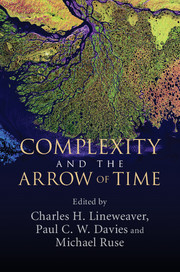Book contents
- Frontmatter
- Contents
- Author biographies
- Part I Introduction
- Part II Cosmological and physical perspectives
- Part III Biological complexity, evolution, and information
- 7 Life: the final frontier for complexity?
- 8 Evolution beyond Newton, Darwin, and entailing law: the origin of complexity in the evolving biosphere
- 9 Emergent order in processes: the interplay of complexity, robustness, correlation, and hierarchy in the biosphere
- 10 The inferential evolution of biological complexity: forgetting nature by learning to nurture
- 11 Information width: a way for the second law to increase complexity
- Part IV Philosophical perspectives
- Index
- References
7 - Life: the final frontier for complexity?
from Part III - Biological complexity, evolution, and information
Published online by Cambridge University Press: 05 July 2013
- Frontmatter
- Contents
- Author biographies
- Part I Introduction
- Part II Cosmological and physical perspectives
- Part III Biological complexity, evolution, and information
- 7 Life: the final frontier for complexity?
- 8 Evolution beyond Newton, Darwin, and entailing law: the origin of complexity in the evolving biosphere
- 9 Emergent order in processes: the interplay of complexity, robustness, correlation, and hierarchy in the biosphere
- 10 The inferential evolution of biological complexity: forgetting nature by learning to nurture
- 11 Information width: a way for the second law to increase complexity
- Part IV Philosophical perspectives
- Index
- References
Summary
The concept of complexity reminds one of the tasting notes of a rare vintage: everybody knows what you are talking about, but the realities continuously slip through our fingers. Moreover, in the scale of complexities most would agree that life is intrinsically more complex than, say, a galaxy. So too we suppose that some sort of metric stretches through the history of life: be it in terms of ecologies, bodyplans or nervous systems. In other words what we see today is manifestly more complex than what was found in the Precambrian. Yet an evolutionary perspective on complexity reveals some unexpected angles. To start with, although the history of life might fall into the cliché of “Once there were bacteria, now there is New York”, in fact when one investigates what are evidently the most primitive representatives of a given group repeatedly they turn out to be “unexpectedly” complex. Many such examples are now available, but amongst the most telling are the eukaryotes. Second, there is the phenomenon of evolutionary inherency, the observation that much that will be required for the emergence of a complex form has already evolved at a substantially earlier stage. A good example involves the protein collagen, essential as a structural molecule in metazoans, but whose origins not only lie deeper in eukaryotic history but whose functions were evidently quite different. Inherency indicates, therefore, that much of complexity is nascent, almost homunculus-like, lying far deeper in the Tree of Life than generally appreciated. Third, whilst the arrow of time seems to lead to ever greater levels of organic complexity, it is as well to remember that these may well include examples that are often dismissed as “simplification” or “regression”.
- Type
- Chapter
- Information
- Complexity and the Arrow of Time , pp. 135 - 161Publisher: Cambridge University PressPrint publication year: 2013
References
- 6
- Cited by



